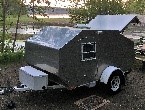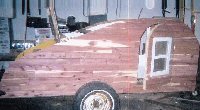Wood Sealer - Water Based vs Oil/Poly
41 posts
• Page 1 of 3 • 1, 2, 3
Wood Sealer - Water Based vs Oil/Poly
I'm not sure who the original "chemist" was on this site that gave the formula for the economical wood sealer = 1 part polyurethane & 3 parts mineral spirits. And that's neither here or there. I know Rod (rlowell) has recently mentioned using it. I like the idea as am considering using it myself.
However, on my way to work, while pondering on some of life’s perplexing issues, questions, and mysteries, I had this thought (didn't say it was a good one)(kind of like one of those throne room thoughts I guess):
Instead of polyurethane/paint thinner, has anyone tried the water based poly thinned with water to the same ratio?(or so) If it would work, it would be more user friendly, easy clean up, less toxic (like that matters to some of us), reduced odor; short term & long term, quicker drying time?
Cons: could rust hardware (screws, staples, etc) if SS or galv fasteners weren't used
Any thoughts on this?
If this thread turns out to be a dud, feel free to kill it and get rid of it.
However, on my way to work, while pondering on some of life’s perplexing issues, questions, and mysteries, I had this thought (didn't say it was a good one)(kind of like one of those throne room thoughts I guess):
Instead of polyurethane/paint thinner, has anyone tried the water based poly thinned with water to the same ratio?(or so) If it would work, it would be more user friendly, easy clean up, less toxic (like that matters to some of us), reduced odor; short term & long term, quicker drying time?
Cons: could rust hardware (screws, staples, etc) if SS or galv fasteners weren't used
Any thoughts on this?
If this thread turns out to be a dud, feel free to kill it and get rid of it.
Whitney & Tracie
Crothersville, IN
We never really grow up, we only learn how to act in public.
Do not confuse what you hear with what I mean.
My build: http://www.tnttt.com/viewtopic.php?t=41955
 -------------------------------
-------------------------------
States we've drug our
li'l camper through. (44 States + Vancouver Island and over 45,000 miles so far)
Crothersville, IN
We never really grow up, we only learn how to act in public.
Do not confuse what you hear with what I mean.
My build: http://www.tnttt.com/viewtopic.php?t=41955
States we've drug our
li'l camper through. (44 States + Vancouver Island and over 45,000 miles so far)
-

WhitneyK - Gold Donating Member
- Posts: 559
- Images: 412
- Joined: Sun Dec 12, 2010 10:28 pm
- Location: IN, Crothersville (36mi N or Louisville)
ok, isnt the solvent suposed to help remove water(dampness) thats in the wood...while the epoxy or varnish/polyurethane seals it. You wouldnt want to seal wet wood the rot process would happen for sure.
Build Thread lil vardo 1: http://tinyurl.com/baqe6py
Build Thread lil vardo 2: http://tinyurl.com/b3rwffm
Build Thread lil vardo 2: http://tinyurl.com/b3rwffm
-

Deryk the Pirate - 500 Club
- Posts: 809
- Images: 158
- Joined: Tue Aug 18, 2009 11:03 am
- Location: Parlin NJ



 Besides the Min. is innocuous ...
Besides the Min. is innocuous ...
 In our extreme Humidity here, things tend to be soaked for a long time ... so I seal the wood , then paint over it too ... As you said , Total encapsulation is the Goal !!! If the water can't get in , it can't Rot eh ....
In our extreme Humidity here, things tend to be soaked for a long time ... so I seal the wood , then paint over it too ... As you said , Total encapsulation is the Goal !!! If the water can't get in , it can't Rot eh ....
 ... and an overhead crane .. just wishing ... Fatuous!!!
... and an overhead crane .. just wishing ... Fatuous!!! 